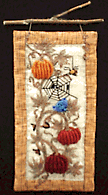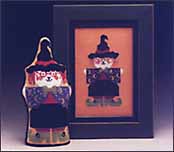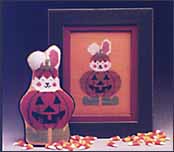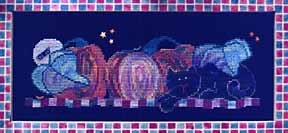Children trick or treating with jack-o-lanterns
swinging and ghosts and goblins billowing in the wind are all part of a
holiday that has become part of American culture. To many needlepoint and
cross stitch designers Halloween has become a popular theme. But few of
us know the origins are not American at all but rather can be traced to
the ancient times of the Celts where it had a very spiritual begining.
And so our monthly feature delves into the fascinating history of this
sometimes eerie and defintely imaginative holiday -- Halloween -- and a
sampling of present day needlework that it has inspired.
The Early Beginnings of
Halloween
 Halloween originated with the Celts, the ancient people
of Great Britain. They observed the feast of Samhain, the God of Death.
This holiday marked the transition from the light half of the year to the
dark. For the Feast of the Dead, or "Dumb Supper", a complete
meal was shared by the living with places set at the table for the dead
as well. Spectacular bonfires were erected and an abundance of vegetables
and bundles of grain were burned as sacrifices to give thanks to Samhain
for a good harvest. (Click on the picture
at left for complete instructions and a FREE pattern "Gene's Pumpkin
Patch" from Karen Cohn, of Dandelion.) Halloween originated with the Celts, the ancient people
of Great Britain. They observed the feast of Samhain, the God of Death.
This holiday marked the transition from the light half of the year to the
dark. For the Feast of the Dead, or "Dumb Supper", a complete
meal was shared by the living with places set at the table for the dead
as well. Spectacular bonfires were erected and an abundance of vegetables
and bundles of grain were burned as sacrifices to give thanks to Samhain
for a good harvest. (Click on the picture
at left for complete instructions and a FREE pattern "Gene's Pumpkin
Patch" from Karen Cohn, of Dandelion.)
Tradition held that on this special night the veil between the two worlds
of life and death (or physical and spiritual) was very thin and that evil
spirits could come out and capture the souls of the dead. Apples were magically
important and they believed that the silver branches of the apple tree
helped the dead souls pass into heaven, which they called Avalon. They
also "wassailed" their apple trees, making a hard cider heated
with spices. Traditionally wassail had apples floating on top. Interestingly,
this may have been the origin of "bobbing for apples".
The belief in witches was very prevalent. Though some held that witches
made a pact with the Devil, enabling them to cast spells, others believed
that the witch was the "Goddess" herself disguised as a n old
crone. She drew her power through the pointed top of her hat and sent it
out to do her bidding via the flared brim. The black dress symbolized the
Goddess' dark (but not evil) side and her broomstick was her shaman's horse
upon which she rode over the moon to other realms and planes.
-
 |
 |
Witch Bunnie (on the left) ---------------- Pumpkin Bunny (on the right)
-
|
- Both original hand painted needlework canvas
designs by Susan Hayes. Adapted to counted cross stitch by Ruth Sparrow)
- (Available from
Twisted Threads - for
ordering information see below.)
|
After the Romans conquered the Celts, they celebrated their own harvest
feast (Pomona) on the night of Samhain, using the customs already in place.
When Christianity spread through the Roman Empire, "All Hallows Even"
( meaning the eve of the Feast of All Saints ) was observed. The Church
chose this day because the people were already accustomed to remembering
the dead at this time of year. The faithful would go "a souling"
from door to door to get money and food as payment for saying prayers for
the dead. This may be how trick-or-treat started. It may also have stemmed
from the May Day traditions of Europe, where children carrying miniature
maypoles, begged for pennies or gifts door to door, threatening the loss
of the fruits of the harvest to anyone who did not contribute.
-

|
Pumpkin Patch
Original applique quilt design by Patti Connor. Adapted for cross stitch by Patti Connor.
(Available from Just
My Imagination. For
ordering information see below) |
Masks, long associated with death, initially were made with the intention
of preserving the likeness of the deceased for posterity. They evolved
to represent the gods, animal creatures , and the souls of the dead and,
as such , were used to frighten away evil spirits, becoming firmly attached
to the traditions of the Samhain celebration.
Early in the 20th century, Halloween got away from its religious origins
and became a night for children to dress up in costume and go from door
to door threatening to trick their neighbors unless treated to sweets and
other goodies. Pumpkins and squash, part of fall's crop and once sacrificed
to the God of Death, are now hollowed out and carved with scary faces.
A candle is then put inside to illuminate the frightful visage. The origins
of the jack-o-lantern are obscure. The name itself used to apply to a natural
phenomenon: the luminous glow in the eastern sky after sunset. It may be
that since sunset in the west symbolized death, this glow in the east represented
the spiritual survival of death.
Our present Halloween customs, with the flying witch, the jack-o-lantern,
the costumes of ghosts and goblins and the ritual of trick-or-treat, transport
us back to an ancient harvest tradition with a rich and colorful past.
-
ORDERING INFORMATION ON ABOVE FEATURED
DESIGNS/DESIGNERS:
Dandelion Designs are available through Dandelion
at 18749 Spooks Hill Rd. Parkton, MD 21120, 410 329-8020 and through Ellen
Nell Inc. at 1-800-499-1224
Pumpkin Bunny and Witch Bunny patterns are widely
available at needlework shops. If your local shop does not carry them,
mail orders are available from Twisted Threads at (800) 434-7374.
Pumpkin Patch is available at needlework shops.
If your shop does not carry it, mail order is available from either Mom
and Me at (618) 537-8343 or Jean's Corner at (800) 806-1307
COPYRIGHT NOTICE: No part of this feature story nor the included designs/charts
can be reproduced or distributed in any form (including electronic) or
used as a teaching tool without the prior written permission of the CARON
Collection Ltd. or the featured designers. One time reproduction priveleges
provided to our web site visitors for and limited to personal use only. |

